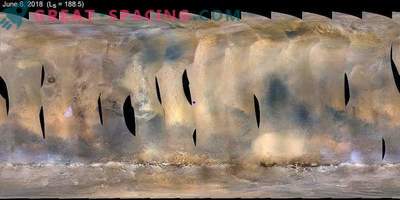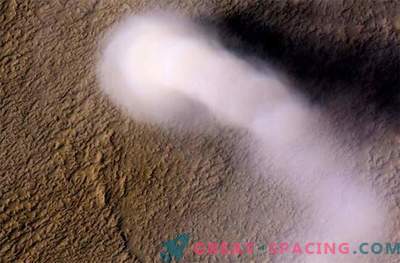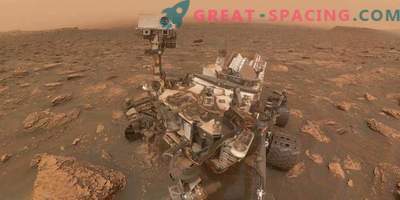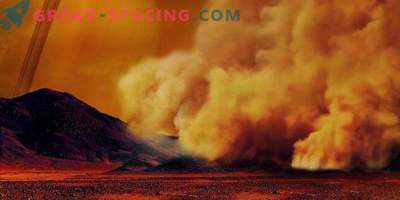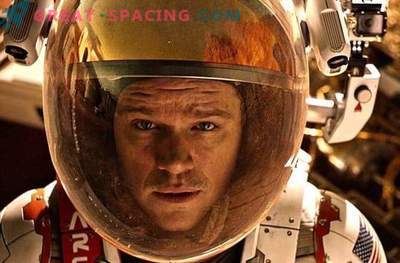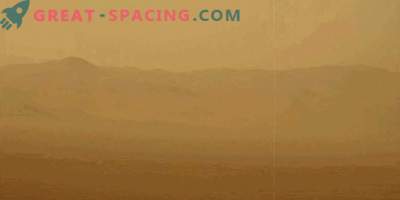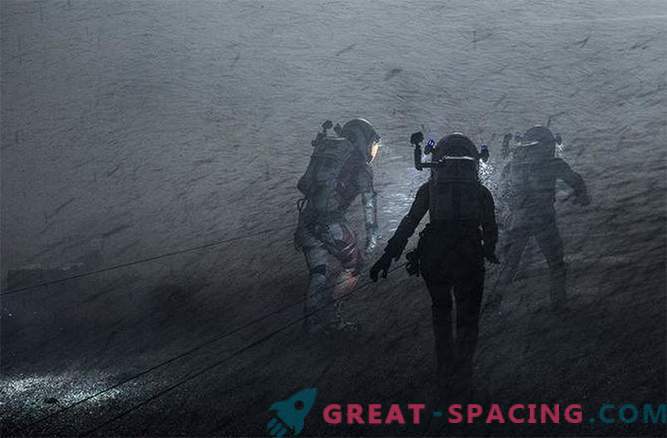
It is known that dust storms are raging on Mars, these storms are incredibly large-scale and can sweep the entire planet. In addition, the surface of Mars is dotted with countless tornadoes, rushing along its plains and raising dust, carried away in a planet’s unique “dust cycle”.
Photos of the surface taken from orbit show that the main cause of erosion on Mars is wind. Vast dune plains, intricate rock formations and skies covered with haze - this is the harsh windy world.
Science fiction writers quickly picked up the idea of frequent storms that look awesome from afar. Gigantic walls of dust against which the greatest earthly dust or sandstorms look like ridiculous dwarfs, glittering spears of lightning caused by atmospheric friction, monstrous hurricanes sweeping everything in their path, throwing astronauts and crushing equipment.
Alas, the reality of the Martian dust storms is somewhat more modest - a fact that NASA wants to convey to the audience, looking forward to Ridley Scott’s new film The Martian.
The action of the film, shot on Andy Weir's bestseller, takes place in the near future during a manned expedition to Mars. Because of the fierce dust storm, the mission fails, the planetary base is damaged, and one of the astronauts, Mark Watney (played by Matt Damon) is lost after the suit damage, and colleagues decide that he died in the creepy Martian winds. But, like many other speculations of science fiction on the topic of Mars, this scene misleads the viewer, as scientists have somewhat different data on its atmospheric pressure.
Although, of course, the dust storms of Mars are dangerous in their own way, it is extremely unlikely that they will scatter someone or anything. The strongest Martian wind blows at a speed of 60 miles per hour (less than 30 meters per second), half as much as some terrestrial hurricane. In fact, however, the damage is caused not so much by the wind speed itself, but by the atmospheric pressure, which is just too tight on Mars. It is about one percent of the earth, so if you decide to go kiting on the Red Planet, you will experience some frustration.
“The main difference between the Earth’s and Mars’s atmospheres is that the pressure on the latter is much lower,” says physicist William Farrell from the Goddard Space Flight Center in Greenbelt, Maryland, analyzing Martian dust storms. "Therefore, of course, the winds are blowing, but not so much."
Although the most violent hurricane on Mars will be more like a breeze by earthly standards, Martian dust storms can still be a problem for future astronauts, especially if they are dependent on solar energy.
In the “Martian”, Watney cleans the solar panels every day so that they do not overgrow with dust. As the experience of the rovers on solar batteries, in particular the veteran NASA Opportunity, who has been traveling on Mars for 10 years on Mars, has shown, this is a serious problem that seriously affects the amount of energy received. When the atmosphere is saturated with fine dust during storms, sunlight hardly reaches the surface. “We are concerned about the power supply of the rovers, this is an important issue,” says scientist Michael Smith, also from the Goddard center. “Spirit and Opportunity Appatars were delivered to the planet in 2004, and so far they have only been in one serious dust storm (in 2007), but then they had to actually stop functioning and go into life-support mode for several weeks.”
But fine dust causes inconvenience not only in connection with solar panels. Not only are its particles magnetized, they are also covered with sharp notches (since there are no other erosion processes on Mars to break in) capable of causing mechanical damage.
“If you saw photos of Curiosity after the trip, remember that it was dug out of the pit, as it were,” added Smith. “Dust covers everything like a blanket and clogs itself in all moving joints.”
The dusty atmosphere of Mars will undoubtedly bring trouble to the ground vehicles, as well as to the health of the astronauts, if we ever send a long-term expedition there (in addition to the increased radiation levels and toxic substances in the Martian regolith and soil). In addition, the causes of planetary dust storms, while studied very poorly.
“Comparatively large dust storms occur on Mars every year, they become continental in size and last for several weeks each,” says Smith. “But every three Martian years (about five and a half terrestrial years) the usual storm grows to planetary dimensions, such we call the“ global dust storm ”.” “Maybe the storm takes time to gather strength. Maybe there is some kind of cycle through which she needs to go, and then get to the right place and launch a new storm, or maybe it's just a matter of chance. ”
Mankind has seen global dust storms on Mars since 1909, the latter happened in 2007, so Mars is just waiting for a new giant.
“We are waiting for a global storm, and this time it promises to be really awesome, so it will be fun,” he says. “I love dust storms.”
With each subsequent storm on Mars, we learn more and more about the processes taking place there in order to better prepare for the first landing on this dusty, unfamiliar planet. But as for the fierce storms, one can be sure that no one except the Martian Watney will be blown away by its winds.


